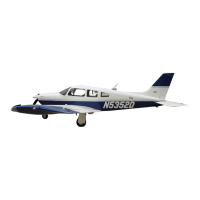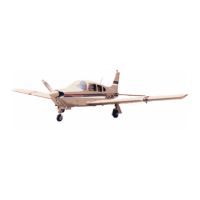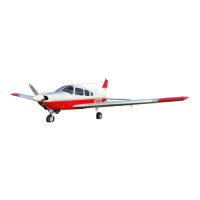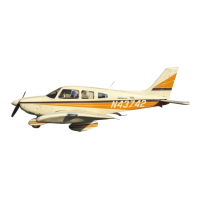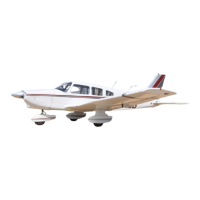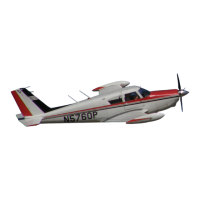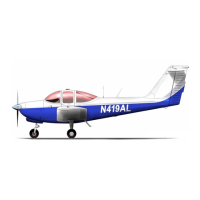Also in the system is a bypass or free-fall valve that allows the gear to drop should a malfunction in the
pump system occur. To prevent the gear from extending too fast, there is a special restrictor fitting on the side
of the valve. The valve is controlled manually or by a gear back-up extension device that is operated by a
pressure sensing device which lowers the gear regardless of gear selector handle position, depending upon
airspeed and engine power (propeller slipstream). Gear extension occurs even if the selector is in the up
position, at airspeeds below approximately 103 KIAS for PA-28RT-201T or 95 KIAS for PA-28RT-201 with
engine power off. The device also prevents the gear from retracting at airspeeds below approximately 78 KIAS
for PA-28RT-201T or 75 KIAS for PA-28RT-201 with full power, though the selector switch may be in the up
position. This speed increases with reduced power and/or increased altitude. The sensing device operation is
controlled by a differential air pressure across a flexible diaphragm which is mechanically linked to the
hydraulic valve and an electrical switch which actuates the pump motor. A high pressure and static air source
for actuating the diaphragm is provided in a mast mounted on the left side of the fuselage above the wing.
Manual override of the device is provided by an emergency gear lever located between the front seats to the
left of the flap handle.
The emergency gear lever, used for emergency extension of the gear, manually releases hydraulic pressure
to permit the gear to free-fall with spring assistance on the nose gear. The lever must be held in the downward
position for emergency extension. This same lever, when held in the raised position, can be used to override
the system, and gear position is controlled by the selector switch regardless of airspeed/power combinations.
The lever must also be held in the raised position when hydraulic system operational checks are being
conducted. An override lock allows the emergency extension lever to be locked in the up override position. A
warning light is mounted below the gear selector lever, and flashes to indicate whenever the lock is in use. The
lock is disengaged by pulling up on the extension lever.
For description of the landing gear and electrical switches, refer to Chapter 32, Landing Gear and Brake
System.
TROUBLESHOOTING.
Malfunctions of the hydraulic system will result in failure of the landing gear to operate properly. When
trouble arises, jack up the airplane (refer to Jacking, Chapter 7) and then proceed to determine the extent of the
trouble. Generally, hydraulic system troubles fall into two types, troubles involving the hydraulic supplying
system and troubles in the landing gear hydraulic system. Chart 2901 lists the troubles which may be
encountered and their probable cause, and suggests a remedy for the trouble involved. A hydraulic system
operational check may be conducted using Figures 29- 1 thru 29-4. When the trouble has been recognized, the
first step in troubleshooting is isolating the cause. Hydraulic system troubles are not always traceable to one
cause. It is possible that a malfunction may be the result of more than one difficulty within the system. Starting
first with the most obvious and most probable reasons for the trouble, check each possibility in turn and, by
process of elimination, isolate the troubles.
—NOTE—
If it is found that the hydraulic pump is at fault and requires
d i s a s s e m b l y, it is recommended that it be overhauled by a
recommended overhaul shop. However, if this cannot be
achieved, minor repairs of the pump such as replacement of
gaskets and motor components, and pressure checks with
adjustments may be accomplished in accordance with
instructions given in Disassembly of Hydraulic Pump through
Test and Adjustment of Hydraulic Pump.
29-00-02
Page 29-06
Revised: November 6, 1979
2B24
PIPER AIRCRAFT
PA-28RT-201 / 201T
MAINTENANCE MANUAL
